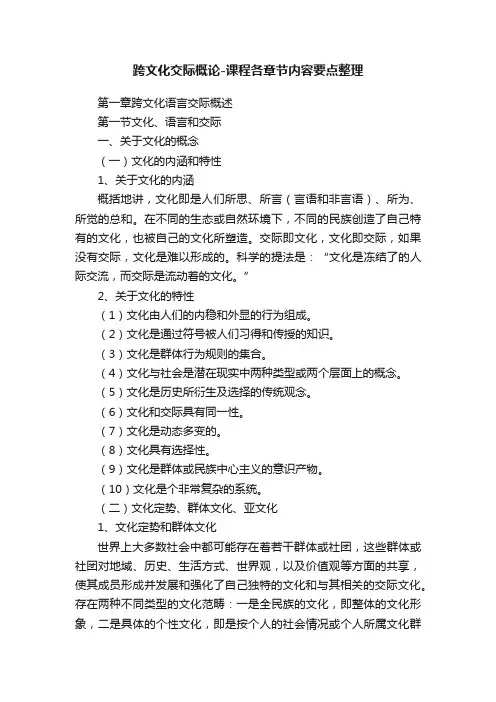跨文化交际chapter7 (2)
- 格式:ppt
- 大小:738.50 KB
- 文档页数:28
![跨文化交际(UNIT 7)[优质ppt]](https://uimg.taocdn.com/45189eb60912a21615792900.webp)


Unit Seven Time and Space Across CulturesI.Warm Up1. Please read the story on page 156. What can we learn from the story?2. Go to answer the questions on Group Work (p235-236) and find out your sense of time?Supplement: Additional materialsII.ChronemicsChronemics is the study of how people perceive and use time.(i) The sense of time:1) Time is linear线形. Western cultures think time is linear — aflow from the past to the present to the future.2) Time is cyclical周期的. Life on earth evolved in response to thecycles of day and night and the ebb and flow潮涨潮落of thetides.(ii) Monochronic出现一次and Polychronic Time (p256-257)1. What is M-Time and P-Time? Which do you think is thedominating time system in our culture?1) Monochronic time means paying attention to and doing only onething at a time – events scheduled as separate items.2) Polychronic time means being involved with many things at once.2. What is the philosophy哲学underlying each of the time system?1) P-time stresses involvement of people and completion完成oftransactions事务rather than adherence to遵守present schedules. Appointments are not taken as seriously and, as a consequence, are frequently broken. P-time is treated as less tangible有形地than M-time.Weakness: Matters in a polychromic多彩的culture seem in a constant state 恒定常态of flux. Appointments are frequently broken.2) In M-time system, social and business life is commonly schedule-dominated. By scheduling, we compartmentalize划分; this makes it possible to concentrate on 集中注意one thing at a time, but it also reduces the context. M-time is also tangible. M-time scheduling is used as a classification system that orders life.Weakness: Life in general is at times unpredictable. M-time reduces the context and alienate使疏远people from themselves and from others.(iii) The Heartbeat of Culture (p229-232)1.What does the author want to tell us from his experience in Braziland the questionnaire between students in Niteroi and those in Fresno?In Brazil, people seem to be very flexible in their concepts of time and punctuality. Brazilians are likely to attribute lateness for appointments to unforeseen circumstances 意外情况that the person couldn’t control. They seem less inclined to倾向于feel personallyresponsible for being late. So they express less regret for their own lateness and blame others less when others are late.The Brazilian students believed that a person who is consistently late is probably more successful than one who is consistently on time.They seemed to accept the idea that someone of status is expected to arrive late. Lack of punctuality is a badge标记of success.2.There aren’t unanimous全体一致perceptions of time时间知觉among culturally different people. Even within one country, ideas of time and punctuality vary considerably from place to place.Different regions and even cities have their own distinct rhythms and rules.3.Appreciating cultural differences in time sense becomes increasinglyimportant as modern communications put more and more people in daily contact. If we are to avoid misreading issues that involve time perceptions, we need to understand better our own cultural biases偏见and those of others.※American Concept of Time: (See Case 25)III.Proxemics人际距离学A fascinating area in the nonverbal world of body language is that of spatial relationships空间关系, or proxemics, the study of man's appreciation and use of space. As a species, man is highly territorial but we are rarely aware of it unless our space is somehow violated. Spatial第3 页共9 页relationships and territorial boundaries directly influence our daily encounters. Maintaining control over such space is a key factor in personal satisfaction; observing spatial interactions in everyday life is a key to personal awareness.(i)The study of proxemics includes three aspects of space: (a) fixed features of space. (b) semifixed features of space, and (c) personal space(a) fixed features of spaceFixed feature space is characterized by unmovable boundaries, like divisions within an office building. Architecture and spacing of buildings also belong to this aspect of space.For example, a person in the United States can drive on a highway for miles and never see a sign of people or dwellings民居. Therefore, he may be amazed at the closeness of people in China.Intercultural communicators need to realize that cultures have alternative approaches变换方法to space and ways of using it.(b) semifixed 半固定features of spaceSemifixed features of space refer to spatial arrangements of movable objects within a room, such as furniture arrangement and seating.1. furniture arrangement :French space is a reflection of French culture. Everything is centralized集中的, and spatially the entire country is laid outaround centers.In Germany, where privacy is stressed, office furniture is spread throughout the office.In Japan, where group participation is encouraged, many desks are arranged hierarchically分等级的in the center of a large, common room absent of walls.Chinese geomancy,feng shui, is the art of arranging the physical environment to establish harmony with the natural environment to achieve happiness, prosperity, and health.2. seatingIn the United States, they tend to talk with those opposite them rather than those seated or stand beside them.The Chinese often experience uneasiness when they face someone directly or sit on opposite side of a desk or table from someone.(c) personal space or private space (p239-241)1. Behavioral study indicates that individuals perceive a distance that is appropriate for different types of messages; they also establish a comfortable distance for personal interaction and nonverbally define this as their personal space. Research supports the hypothesis 假设that the violation违反侵害of this personal space can have serious adverse effects不利影响on communication. Thus, if an individual is to be mutually 互相satisfied in a communication encounter his/her第5 页共9 页personal space must be respected. Should an intruder侵入者invade 侵略干扰this personal space while also trespassing 擅自进入within territorial boundaries he placed himself in double jeopardy双重负担and must compensate 弥补for the other's increased anxiety.2. The differences among Americans, the India, the Japanese and the ArabIn the United States, Hall reports that psychologists have identified four zones from which U.S. people interact: the intimate zone亲密区, the personal zone, the social zone, and the public zone.The study of spatial territory for the purpose of communication uses four categories for informal space: the intimate distance for embracing or whispering (6-18 inches), the personal distance for conversations among good friends (1.5-4 feet), social distance for conversations among acquaintances (4-12 feet), and public distance used for public speaking (12 feet or more).intimate distance ranging from direct contact to about 45cm, which applies to the closest relationships such as husband and wifepersonal distance ranging from 45 to 80cm, which is usually maintained for conversations between friends & relativessocial distanceranging from 1.3to 2 meters, which covers people第 7 页 共9 页who work together or are meeting at socialgatheringspublicdistance such as that kept between a lecturer and his audienceIn India , there are elaborate rules about how closely members of each caste 印度的社会等级 may approach other castes.In Japan, the private bubble and the personal space are more a creation of the mind than an actual existence 真实存在. The Japanese connect privacy with mental space. In crowds each Japanese becomes an island and he is alone as long as he does not acknowledge any of the other people.In Arab , Arabs of the same sex do stand much closer than North Americans. An Arab entering an elevator may stand right next to another person and be touching even though no one else is in the elevator.(ii) TerritorialityTerritoriality refers to how space can be used to communicate messages.Territorial claims differ from personal space in that the personal zone accompanies the individual while territoriality is relatively stationary 固定的. Semi-fixed feature space is often the criteria 标准 used to establish a territory within any environment; it becomes a man's safety zone where he rests from the rigors 严格 of defending personal space from invasion, thedramatic or sudden entry into another's personal zone. Humans, like animals, indicate their ownership of this established territory and will consequently defend it against all invasions. Territoriality is established so rapidly that even the second session 会话in a series of lectures讲座is sufficient to find most of the audience returning to their same seats. And if one has been sitting in a particular seat and someone else occupies it, one can notice a fleeting 短暂的irritation.Compare the differences among the cultures of the countries mentioned in “Home in Various Cultures” (p244-247).America: showing visitors around home; people are not allowed to lock doors except the bathroom door; kitchen is the place for negotiation between the mother and the children; the parents’ bedroom is mostly off-limits.Germany: requires a wide area of privacy, formal and regimented; doors are firmly shut between rooms; an entrance hall 门廊to lead visitors into the house without showing specific rooms and spoiling the family’s privacy.Northern European countries: rude if not call in advance; not to expect the tour of the host’s home.France: never drop in unannounced; no tour of the house; guests are usually received in the living room, with the doors to the other rooms closed.Italy: you can drop in anytime without calling first, except for the resting hours of 2:00 to 4:00 pm.Spain: call ahead; normal visiting hours are 4:00 to 6:00 pm.Latin American countries: guests, even dropping in without warning, are greeted warmly, often with hugs and kisses; to communicate in the dining room.The Middle Eastern countries: the layout of the salon;IV.Case Study: Students are required to read the cases given carefully and try to analyse them from the viewpoint of IC.第9 页共9 页。






Chapter 1 CultureI.定义Culture(from intellectual perspective):从知性角度定义文化:作为整体的人类智力成就的艺术和其他表现Culture(from anthropologic perspective):从人类学角度定义文化:文化有清晰和模糊的行为模式构成,这些模式通过符号获得并传播,这些符号有人类群体的特别成就构成,包括具体的人工制品。
文化的基本核心由传统思想和与其相关的价值观构成。
Culture(from psychological perspective) : 从心理学角度定义文化:文化是使一个人类群体成员区别于其他人类群体的思维的总体规划。
Culture(from sociological perspective):从社会学角度定义文化:文化是一种可习得的,基于群体的认知模式——包括言语与非言语符号,态度,价值观,信仰和非信仰系统以及行为。
Culture(from intercultural communication perspective):从跨文化交际学角度定义文化:文化是个人和群体在种族发展过程中所获得的知识,经验,信仰,价值观,行为,态度,阶级,宗教,时间观,角色,空间观和艺术品的集合。
Culture Identity: 文化身份:认为自己归属于某一文化或民族群体的感觉。
Subculture亚文化:指存在于主流文化中的文化,其划分通常基于经济地位,社会阶层,民族,种族或地理区域。
Co-culture 共文化——指具有独特的交际特征,感知特点,价值观,信仰和行为,区别于其他群体,社团以及主流文化的群体或社团。
Subgroup 亚群体——相对于亚文化和共文化群体,亚群体通常规模不大,也不一定有文化群体时代相传积累的价值观念和行为模式。
Chapter 2 Communication and Intercultural Communication1. Sender/Source信息发出者/信息源:指传递信息的人2. Message信息:只引起信息接受者反应的任何信号。


跨文化交际概论-课程各章节内容要点整理第一章跨文化语言交际概述第一节文化、语言和交际一、关于文化的概念(一)文化的内涵和特性1、关于文化的内涵概括地讲,文化即是人们所思、所言(言语和非言语)、所为、所觉的总和。
在不同的生态或自然环境下,不同的民族创造了自己特有的文化,也被自己的文化所塑造。
交际即文化,文化即交际,如果没有交际,文化是难以形成的。
科学的提法是:“文化是冻结了的人际交流,而交际是流动着的文化。
”2、关于文化的特性(1)文化由人们的内稳和外显的行为组成。
(2)文化是通过符号被人们习得和传授的知识。
(3)文化是群体行为规则的集合。
(4)文化与社会是潜在现实中两种类型或两个层面上的概念。
(5)文化是历史所衍生及选择的传统观念。
(6)文化和交际具有同一性。
(7)文化是动态多变的。
(8)文化具有选择性。
(9)文化是群体或民族中心主义的意识产物。
(10)文化是个非常复杂的系统。
(二)文化定势、群体文化、亚文化1、文化定势和群体文化世界上大多数社会中都可能存在着若干群体或社团,这些群体或社团对地域、历史、生活方式、世界观,以及价值观等方面的共享,使其成员形成并发展和强化了自己独特的文化和与其相关的交际文化。
存在两种不同类型的文化范畴:一是全民族的文化,即整体的文化形象,二是具体的个性文化,即是按个人的社会情况或个人所属文化群体为基础的文化,有的学者把这种文化称之为群体文化或副文化。
2、亚文化与亚群体在跨文化交际研究中,对文化分类的一种较为传统的做法是把文化分成主流文化和亚文化。
亚文化是指存在于某一主流文化之中的一种非主流文化,某一少数群体的文化,这一文化中的行为模式区别于主流文化的行为模式。
二、关于语言的概念(一)语言是交际工具1、交际媒介言语交际是人类社会中必需的另一种交换活动,交换的是信息、思想、情感。
语言就是一个符号系统,一个人脑子里贮存了符号和符号的组合规则,他就可以和别人交际,传情达意,沟通信息。
《跨文化交际学》第7章跨文化交际学第7章(第1节)是关于跨文化沟通的重要概念和理论的介绍。
本章主要讨论了跨文化交际的定义、特点以及对跨文化交际的理解和引导的重要性。
以下是对本章内容的较为详细的总结。
跨文化交际即在不同文化背景下进行的交际活动。
在全球化的今天,跨文化交际已经成为人们日常生活中不可避免的一部分。
了解和应用跨文化交际学的理论和方法,对于促进文化间的相互理解和沟通有着重要的意义。
首先,本节明确了跨文化交际的特点。
跨文化交际存在着文化差异、语言障碍、非语言行为等问题,这些问题会影响到交际双方的理解和沟通效果。
而且,跨文化交际是一个动态的过程,受到社会、历史和政治等因素的影响。
其次,本节介绍了跨文化交际学的定义和研究内容。
跨文化交际学是研究人类不同文化间交际行为和交际现象的学科。
它关注文化差异对交际的影响,以及如何理解和适应跨文化环境中的交际情境。
跨文化交际学的研究内容包括文化差异的认知、非语言交际、语言和语境的关系等。
接着,本节介绍了跨文化交际学的重要性。
了解跨文化交际学的理论和方法可以帮助人们更好地理解并处理跨文化交际中的问题。
通过学习跨文化交际,人们可以提高自身的文化意识和文化敏感性,增进与他人的交流理解,促进世界各地不同文化的和谐与发展。
最后,本节介绍了跨文化交际学的研究方法。
跨文化交际学采用综合性和跨学科的研究方法,如实地调查、实验、对比分析等。
研究者通常需要了解不同文化间的差异和相似之处,并根据具体交际情境进行有效的分析和解释。
综上所述,跨文化交际学是一个重要的学科,它能够帮助人们更好地理解和应对跨文化交际中的问题。
通过学习跨文化交际学的理论和方法,人们可以提高自身的文化意识和认知水平,增进与他人的交流理解,促进文化之间的和谐与发展。
因此,掌握跨文化交际学的知识对于现代人们来说具有重要的意义。
Unit Seven Time and Space Across CulturesI.Warm Up1. Please read the story on page 156. What can we learn from the story?2. Go to answer the questions on Group Work (p235-236) and find out your sense of time?Supplement: Additional materialsII.ChronemicsChronemics is the study of how people perceive and use time.(i) The sense of time:1) Time is linear线形. Western cultures think time is linear — aflow from the past to the present to the future.2) Time is cyclical周期的. Life on earth evolved in response to thecycles of day and night and the ebb and flow潮涨潮落of thetides.(ii) Monochronic出现一次and Polychronic Time (p256-257)1. What is M-Time and P-Time? Which do you think is thedominating time system in our culture?1) Monochronic time means paying attention to and doing only onething at a time – events scheduled as separate items.2) Polychronic time means being involved with many things at once.2. What is the philosophy哲学underlying each of the time system?1) P-time stresses involvement of people and completion完成oftransactions事务rather than adherence to遵守present schedules. Appointments are not taken as seriously and, as a consequence, are frequently broken. P-time is treated as less tangible有形地than M-time.Weakness: Matters in a polychromic多彩的culture seem in a constant state 恒定常态of flux. Appointments are frequently broken.2) In M-time system, social and business life is commonly schedule-dominated. By scheduling, we compartmentalize划分; this makes it possible to concentrate on 集中注意one thing at a time, but it also reduces the context. M-time is also tangible. M-time scheduling is used as a classification system that orders life.Weakness: Life in general is at times unpredictable. M-time reduces the context and alienate使疏远people from themselves and from others.(iii) The Heartbeat of Culture (p229-232)1.What does the author want to tell us from his experience in Braziland the questionnaire between students in Niteroi and those in Fresno?In Brazil, people seem to be very flexible in their concepts of time and punctuality. Brazilians are likely to attribute lateness for appointments to unforeseen circumstances 意外情况that the person couldn’t control. They seem less inclined to倾向于feel personallyresponsible for being late. So they express less regret for their own lateness and blame others less when others are late.The Brazilian students believed that a person who is consistently late is probably more successful than one who is consistently on time.They seemed to accept the idea that someone of status is expected to arrive late. Lack of punctuality is a badge标记of success.2.There aren’t unanimous全体一致perceptions of time时间知觉among culturally different people. Even within one country, ideas of time and punctuality vary considerably from place to place.Different regions and even cities have their own distinct rhythms and rules.3.Appreciating cultural differences in time sense becomes increasinglyimportant as modern communications put more and more people in daily contact. If we are to avoid misreading issues that involve time perceptions, we need to understand better our own cultural biases偏见and those of others.※American Concept of Time: (See Case 25)III.Proxemics人际距离学A fascinating area in the nonverbal world of body language is that of spatial relationships空间关系, or proxemics, the study of man's appreciation and use of space. As a species, man is highly territorial but we are rarely aware of it unless our space is somehow violated. Spatialrelationships and territorial boundaries directly influence our daily encounters. Maintaining control over such space is a key factor in personal satisfaction; observing spatial interactions in everyday life is a key to personal awareness.(i)The study of proxemics includes three aspects of space: (a) fixed features of space. (b) semifixed features of space, and (c) personal space(a) fixed features of spaceFixed feature space is characterized by unmovable boundaries, like divisions within an office building. Architecture and spacing of buildings also belong to this aspect of space.For example, a person in the United States can drive on a highway for miles and never see a sign of people or dwellings民居. Therefore, he may be amazed at the closeness of people in China.Intercultural communicators need to realize that cultures have alternative approaches变换方法to space and ways of using it.(b) semifixed 半固定features of spaceSemifixed features of space refer to spatial arrangements of movable objects within a room, such as furniture arrangement and seating.1. furniture arrangement :French space is a reflection of French culture. Everything is centralized集中的, and spatially the entire country is laid outaround centers.In Germany, where privacy is stressed, office furniture is spread throughout the office.In Japan, where group participation is encouraged, many desks are arranged hierarchically分等级的in the center of a large, common room absent of walls.Chinese geomancy,feng shui, is the art of arranging the physical environment to establish harmony with the natural environment to achieve happiness, prosperity, and health.2. seatingIn the United States, they tend to talk with those opposite them rather than those seated or stand beside them.The Chinese often experience uneasiness when they face someone directly or sit on opposite side of a desk or table from someone.(c) personal space or private space (p239-241)1. Behavioral study indicates that individuals perceive a distance that is appropriate for different types of messages; they also establish a comfortable distance for personal interaction and nonverbally define this as their personal space. Research supports the hypothesis 假设that the violation违反侵害of this personal space can have serious adverse effects不利影响on communication. Thus, if an individual is to be mutually 互相satisfied in a communication encounter his/herpersonal space must be respected. Should an intruder侵入者invade 侵略干扰this personal space while also trespassing 擅自进入within territorial boundaries he placed himself in double jeopardy双重负担and must compensate 弥补for the other's increased anxiety.2. The differences among Americans, the India, the Japanese and the ArabIn the United States, Hall reports that psychologists have identified four zones from which U.S. people interact: the intimate zone亲密区, the personal zone, the social zone, and the public zone.The study of spatial territory for the purpose of communication uses four categories for informal space: the intimate distance for embracing or whispering (6-18 inches), the personal distance for conversations among good friends (1.5-4 feet), social distance for conversations among acquaintances (4-12 feet), and public distance used for public speaking (12 feet or more).intimate distance ranging from direct contact to about 45cm, which applies to the closest relationships such as husband and wifepersonal distance ranging from 45 to 80cm, which is usually maintained for conversations between friends & relativessocial distanceranging from 1.3to 2 meters, which covers peoplewho work together or are meeting at social gatheringspublic distance such as that kept between a lecturer and his audienceIn India, there are elaborate rules about how closely members of each caste印度的社会等级may approach other castes.In Japan, the private bubble and the personal space are more a creation of the mind than an actual existence真实存在. The Japanese connect privacy with mental space. In crowds each Japanese becomes an island and he is alone as long as he does not acknowledge any of the other people.In Arab, Arabs of the same sex do stand much closer than North Americans. An Arab entering an elevator may stand right next to another person and be touching even though no one else is in the elevator.(ii) TerritorialityTerritoriality refers to how space can be used to communicate messages. Territorial claims differ from personal space in that the personal zone accompanies the individual while territoriality is relatively stationary固定的. Semi-fixed feature space is often the criteria标准used to establish a territory within any environment; it becomes a man's safety zone where he rests from the rigors严格of defending personal space from invasion, thedramatic or sudden entry into another's personal zone. Humans, like animals, indicate their ownership of this established territory and will consequently defend it against all invasions. Territoriality is established so rapidly that even the second session 会话in a series of lectures讲座is sufficient to find most of the audience returning to their same seats. And if one has been sitting in a particular seat and someone else occupies it, one can notice a fleeting 短暂的irritation.Compare the differences among the cultures of the countries mentioned in “Home in Various Cultures” (p244-247).America: showing visitors around home; people are not allowed to lock doors except the bathroom door; kitchen is the place for negotiation between the mother and the children; the parents’ bedroom is mostly off-limits.Germany: requires a wide area of privacy, formal and regimented; doors are firmly shut between rooms; an entrance hall 门廊to lead visitors into the house without showing specific rooms and spoiling the family’s privacy.Northern European countries: rude if not call in advance; not to expect the tour of the host’s home.France: never drop in unannounced; no tour of the house; guests are usually received in the living room, with the doors to the other rooms closed.Italy: you can drop in anytime without calling first, except for the resting hours of 2:00 to 4:00 pm.Spain: call ahead; normal visiting hours are 4:00 to 6:00 pm.Latin American countries: guests, even dropping in without warning, are greeted warmly, often with hugs and kisses; to communicate in the dining room.The Middle Eastern countries: the layout of the salon;IV.Case Study: Students are required to read the cases given carefully and try to analyse them from the viewpoint of IC.。
Chapter VII Intercultural Communication BarriersⅠTeaching Objectives1.To understand the intercultural communication barriers2.To understand the translation problems3.To understand how to overcome intercultural communication barriersⅡLeading inⅢTeaching ProceduresStep1Lead-in case:Mr. Wang, the Chairman of Board of Directors of a Chinese firm, told a story on CCTV program "Dialogue" of how he once almost lost a valuable Canadian employee working for him in Vancouver. He emailed every day to the Canadian, inquiring for the index number he was most concerned about. To his great astonishment, his Canadian employee turned in his resignation after a week. Mr. Wang was puzzled how he could do that to him as he gave such great attention to his job. A Chinese employee would have been more than happy if his or her boss had showed such great concern for him or her. He then found out that, unlike Chinese employees, the Canadian took what meant great concern to Chinese as distrust. But Mr. Wang assumed unconsciously that the Canadian was more similar to his Chinese employees than he actually was and treated him just as he treated any Chinese employee.Ask students warming-up questions:●Why does the Canadian employee turn in his resignation?●What kind of response will a Chinese employee have if a boss showed great concern for himor her?●What are the reasons of this communication barrier?Step27.1 Common problems and barriers in intercultural communicationAnxietyPresent the film The Year of the Yao, which shows Yao’s anxiety about new environment, language and cooperation with the team.Anxiety occurs because of not knowing what one is expected to do, and focusing on that feeling and not be totally present in the communication transaction.Case Analysis: Unnecessary Anxiety or Not?Sugawara (1993) surveyed 168 Japanese employees of Japanese companies working in the United States and 135 of their U.S coworkers. Only 8% of the U.S. coworkers felt impatient with the Japanese coworkers’ English. While 19% of the Japanese employees felt their spoken English was poor or very poor and 20% reported feeling nervous when speaking English with U.S. coworkers, 30% of the Japanese employees felt that the U.S. coworkers were impatient with their accent, and almost 60% believed that language was the problem in communicating with the U.S. coworkers. For some Japanese workers, anxiety over speaking English properly contributed to avoiding interactions with the U.S. coworkers and limiting interactions both on and off the job to other Japanese only.Assuming similarity instead of differenceA case about the experience of a Danish woman (in the textbook: P96)Present a film to the students: The Guasha TreatmentBeijingers in New York (TV seriers which shows that Wang Qiming assumes their friends will take good care of his wife and himself and offer good accommodation when they first come to New York, but on the contrary the friend went away after welcoming them at the airport and left themalone in a totally strange street.)EthnocentrismLet students see part of the film The King and I (or the new version Anna and the King) in which the King, prince and the concubines of Siam think their country is superior than other countries even the very strongest country England in the seventeenth century.Ethnocentrism means, by the definition of the Webster’s Third New International Dictionary: (1) a habitual disposition to judge foreign peoples or groups by the standards and practices of one’s own culture(2) a tendency toward viewing alien cultures with disfavor and a resulting sense of inherent superiorityCase Analysis: You Are Well BlessedOr Role-Play: we can let three students role-play in the class: one Chinese host, an American lady, and an interpreterYang GuifeiVarious forms of ethnocentric attitude:My culture should be the role model for other cultures.I have little respect for the values and customs of other cultures.Most people would be happier if they lived like people in my culture.People in my culture have just about the best lifestyles of anywhere.I do not cooperate with people who are different.I do not trust people who are different.I dislike interacting with people from different cultures.Stereotypes and prejudicea.StereotypesStereotypes are the perceptions or beliefs we hold about groups or individuals based on previously formed opinions and attitudes.PARISIN THETHE SPRINGThe conservative and gentlemen-like EnglishThe demonstrative and talkative ItaliansThe music-loving, masculine LatinosCulture ImageEnglish conservative, reserved, polite, proper, formal French arrogant (傲慢的, 自大的), rude, chauvinistic (沙文主义的), romantics,gourmets (能精选品评美食、美酒的人), cultural, artisticItalians demonstrative, talkative, emotional, romantics, bold, artistic Latin Americans manana attitude, macho (男子气的), music lovers, touchersCase Analysis: StereotypingCase Analysis: A Tragedy in U.S Historyb. PrejudiceShow the following pictures to the students and let them discuss the communication barriers involved.Stereotyped Chinese northernersPrejudice refers to the irrational dislike, suspicion, or hatred of a particular group, race, religion, or sexual orientation.Case Analysis: An Interesting ExperimentShow the film Pride and Prejudice which shows the prejudice Elizabeth holds toward Darcyc.RacismRacism is any policy, practice, belief, or attitude that attributes characteristics or status to individuals based on their race.d.The role of communicationWhat are the reasons for the persistence of prejudice, ethnocentrism, stereotypes and racism? SocializationSocial benefitsEconomic benefitsPsychological benefitsHate SpeechHate speech refers to hostile words or actions that people say or do against a certain group because that group is different.7.1.5 Language problemsa. Sapir-Whorf hypothesisLinguistic determinist is that language structure controls thought and cultural norms.Linguistic relativity is more scientific. It holds that culture is controlled by and controls language.b. Translation problemsAxtell (1991) identifies a number of U.S. translation problems:1) General Motors automobile "Nova" in Spanish means "doesn't go";2) Pepsi-Cola's "Come Alive with Pepsi" when translated in Taiwanese is "Pepsi brings your ancestors back from the grave";3) Electrolux, a Swedish manufacturer, used "Nothing sucks like an Elecrolux," which failed because of the slang meaning of suck in the United States;4) Bich pens were originally named Bich by their French manufacturer.What led to translation problems?The lack ofa.V ocabulary equivalencemokusatsu:b. Idiomatic equivalenceThe old man kicked the bucket.???c. Grammatical-syntactical equivalenceAsk students the different meanings of “book a place” and “place a book” by changing the verb and noun of the phased. Experiential equivalenceTell students the meanings of department store, shopping mall, and plaza.e. Conceptual equivalence.Corruption in Singapore is an anti-law behavior while in Thailand it is only morally wrong which led to the corruption of the whole society, from the president to the common taxi-driver.7.2 Overcoming Intercultural Communication Barriers7.2.1 Raise awarenessa.Self-awarenessb.Consciousness of one’s values and biases and their effectc.Necessity of becoming comfortable with differencesd.Sensitivity to circumstances7.2.2 Obtain knowledgeWe can obtain knowledge by reading books, surfing on the internet and communicating with people from different cultures.7.2.3 Enhance motivation7.2.4 Master skillsCultural-general skillsCultural-specific skillsStep3Raising Intercultural Awareness:文化定势:通过描述对不同群体或个人的印象,了解文化定势现象,学习文化定势产生的原因、优点和缺点。